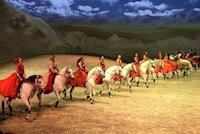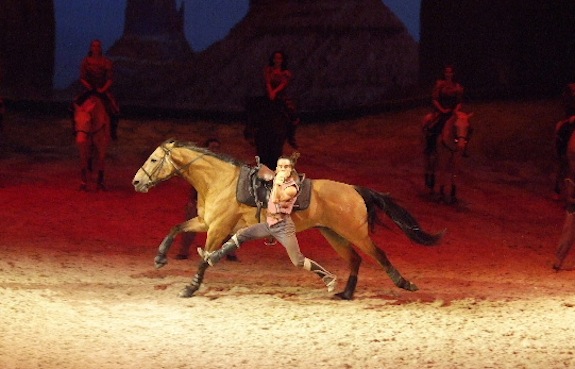Following a ten day vacation at Hummingbird Nest Ranch in the Santa Susana Mountains, location of many film shoots, the celebrity equines of Cavalia’s Odysseo arrived in Burbank, California in late February.
I felt privileged to attend the premiere of its all-new, mesmerizing production. Created by one of the founders of Cirque du Soleil, Cavalia’s Odysseo is a theatrical ode to horse and man that combines the equestrian and acrobatic arts with high-tech special effects set under a magical, 10-story white big top. The show culminates in spectacular scene in which horses and riders perform in 80,000 gallons of water that create a visually stunning lake at the base of a waterfall.
The surreal dream world of Cavalia could not exist without the horsemanship and barn managing skills of Marc-Olivier Leprohan, who also acts as Cavalia’s artistic and equestrian coordinator. I had a chance to speak with Marc-Olivier soon after the show’s premiere.
Horse & Style: How many horses travel with you?
Marc-Olivier Leprohan: 67
H&S: Do they rotate in and out of the show?
MOL: Yes. We have back up horses for every number. We try to rotate the horses so they don’t get bored. Each horse will do more than one discipline which keeps them challenged and alert.
H&S: Does the rider have responsibility for the care of the horse he or she rides in the performance?
MOL: All of the riders are responsible for the horses they have been assigned to. They ride them every day before the show to stretch them and to improve the level of dressage. The riders that we have are passionate. They live and breathe horses. They are not just performers who arrive to do a show. They invest time, energy and sweat every day. A typical day begins around 10am and may not end until midnight.
H&S: I believe treats are used as a training method in your show. Recently one of the show jumping Grand Prix riders was criticized for the use of treats as reward, danger of horse getting mouth locked on stirrup as it turns to get a treat was cited- do you have any thoughts on this?
MOL: We don’t use treats in our training. However, we do give treats simply because we love the horses. In no way do we present the treats as a reward to enforce a good action. The reward is the affection that the trainer shows to the horses. You can see that bond live in every one of our performances.
H&S: Are the mares stabled seperately from the geldings and stallions?
MOL: We don’t have any mares in the show. There are 20 stallions and 47 geldings. If we had mares the males would fight over them.
H&S: Do the horses have a special diet, hay, cubes, pellets? Do you travel with your own food or buy it from local feed stores?
MOL: Each horse has their own diet that is followed by our stable team and our veterinarian. Throughout the US, we use the same hay no matter where we are. It is Timothy hay. The goal is to keep a consistency in their diet which helps manage their overall well-being. We use a Purina grain. The horses eat 3 meals of grain and 5 meals of hay each day. The quantity changes depending on what activity the horse is doing in the show, its size and its age.
H&S: Do most of the horses go barefoot or in shoes? Caulks if you have a water scene?
MOL: We shoe the horses that need it. Our blacksmith who travels with us follows the health of their feet really consciously.
H&S: How do you deal with night watch?
MOL: We always have our vet on call if anything happens. A rider and two grooms are on site at all times.
H&S: You manage a massive amount of livestock. How are they transported? I imagine the paperwork is nightmare. Does a vet travel with you just to deal with the Coggins?
MOL: We do have a vet who is travelling at all times with us. He does have an assistant as well. We are dealing with local vets to do the Coggin and health certificate. The paperwork to transport the horses is challenging especially when you are crossing a border. We need to follow local, federal and state law and they are not always the same everywhere. Before every premiere, there is a USDA vet who certifies the facility. We are proud of our horses’ care. In fact Rendez-Vous ticket holders can visit the stable after the show and can see how well the horses are.We normally transport the horses by truck with Brookledge. For long distance, the horses are in 8 boxes per truck so they can be confortable for the ride. We stop a few times during the transport to give more hay and water. We do 1 big stop every couple of days to rest the horses and so they can enjoy the natural life.
H&S: Do you have any humorous stories about horse mix-ups or mishaps with tack?
MOL: It’s a live show, so plenty of stuff can happen. We did send someone on stage without a saddle for one number because the saddle broke during the warm up of the horse and we didn’t have the time to change it. We had one horse who chewed his reins before the show and the rider didn’t see it. He went on stage and the reins broke during a counter figure in a dressage group number. The rider managed to make a necklace with what was left of the reins and he finished the number without any control on the mouth of the horse.
H&S: What do you do to keep the horses fresh and interested in their job?
MOL: The horses are trained in many disciplines. We make a lot of rotations so they don’t get bored of doing the same thing over and over. The riders have a close relationship between the horses and them. If we feel there is a horse that doesn’t fit well, we are not going to use him. We have back-ups for all the acts.
H&S: How far in advance do you plan the theme of the next show and are you scouting for new acts all the time?
MOL: Odysseo was created over a two year period. Many of the artists in the show today were part of the creation.
H&S: Some of the horses layed over at the Saperstein’s Hummingbird Nest Ranch, luxurious digs – what were your impressions of the facility? Did the horses enjoy it?
MOL: We did really enjoy that place. It is a nice farm and really relaxing for the horses. We have been to that place more than once.
-by Winter Hoffman. Photos courtesy Cavalia




Leave A Comment
You must be logged in to post a comment.